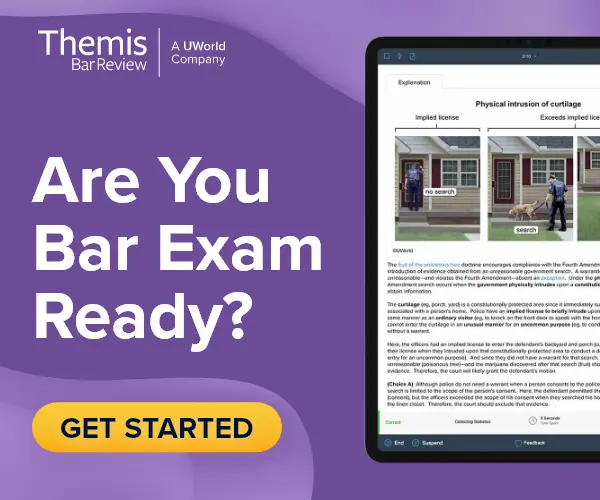Passing the bar exam is a defining moment for every law graduate. Success rates, though, vary widely by state, law school, and number of test-taking attempts. Here’s a breakdown of national and state pass rates from the National Conference of Bar Examiners (NCBE®), along with tips to pass the bar exam on your first attempt.
State-Wise Bar Exam Pass Rates 2025
Bar exam pass rates can be categorized into Overall Pass Rate and First-Time Pass Rate, allowing for a more in-depth analysis. The percentage of students who pass the bar exam on their first try is typically higher than the overall pass rate for all test-takers in a state.
During the past 10 years, bar exam pass rates have seen a noticeable shift. The average pass rate for February 2025 bar exam is 47%, which is line with the passing trends, and is expected to be higher for July 2025.
| Jurisdiction | 2025* | 2024 | 2023 | 2022 | 2021 | 2020 | 2019 | 2018 | 2017 | 2016 | 2015 |
|---|---|---|---|---|---|---|---|---|---|---|---|
| Alabama | 28% | 57% | 54% | 48% | 48% | 46% | 52% | 46% | 52% | 53% | 54% |
| Alaska | 48% | 64% | 58% | 62% | 64% | 49% | 59% | 53% | 61% | 62% | |
| Arizona | 51% | 69% | 68% | 57% | 62% | 62% | 58% | 53% | 50% | 51% | 57% |
| Arkansas | 52% | 72% | 70% | 67% | 70% | 57% | 53% | 63% | 57% | 65% | |
| California | 64% | 54% | 52% | 47% | 48% | 50% | 43% | 36% | 44% | 40% | 44% |
| Colorado | 53% | 80% | 74% | 65% | 67% | 71% | 69% | 64% | 69% | 69% | 69% |
| Connecticut | 34% | 63% | 56% | 58% | 55% | 59% | 53% | 49% | 64% | 67% | 72% |
| Delaware | 53% | 67% | 64% | 67% | — | 52% | 60% | 69% | 66% | 66% | |
| District of Columbia | 43% | 79% | 78% | 66% | 67% | 64% | 63% | 62% | 64% | 57% | 42% |
| Florida | 46% | 65% | 61% | 49% | 56% | 53% | 56% | 51% | 55% | 54% | 59% |
| Georgia | 49% | 70% | 70% | 61% | 58% | 59% | 56% | 53% | 58% | 62% | 64% |
| Hawaii | 63% | 68% | 63% | 71% | 68% | 63% | 68% | 68% | 71% | 66% | |
| Idaho | 51% | 71% | 66% | 64% | 63% | 64% | 67% | 74% | 72% | 69% | |
| Illinois | 40% | 72% | 70% | 61% | 66% | 66% | 66% | 69% | 69% | 74% | |
| Indiana | 47% | 73% | 70% | 64% | 68% | 60% | 60% | 61% | 61% | 71% | |
| Iowa | 34% | 84% | 86% | 68% | 73% | 73% | 74% | 78% | 68% | 82% | |
| Kansas | 54% | 76% | 77% | 73% | 83% | 84% | 66% | 75% | 72% | 78% | |
| Kentucky | 50% | 77% | 76% | 68% | 68% | 64% | 63% | 61% | 70% | 71% | |
| Louisiana | 56% | 66% | 70% | 64% | 55% | 65% | 66% | 68% | 65% | 63% | |
| Maine | 43% | 73% | 68% | 59% | 75% | 46% | 55% | 63% | 68% | 61% | |
| Maryland | 38% | 63% | 59% | 60% | 62% | 61% | 51% | 55% | 60% | 58% | |
| Massachusetts | 46% | 76% | 73% | 73% | 67% | 67% | 65% | 62% | 64% | 65% | 68% |
| Michigan | 38% | 64% | 55% | 59% | 67% | 60% | 63% | 64% | 65% | 61% | |
| Minnesota | 53% | 84% | 79% | 69% | 74% | 70% | 69% | 68% | 71% | 73% | |
| Mississippi | 47% | 80% | 73% | 67% | 71% | 65% | 48% | 52% | 69% | 75% | |
| Missouri | 51% | 80% | 81% | 72% | 75% | 73% | 72% | 79% | 78% | 83% | |
| Montana | 41% | 81% | 82% | 71% | 76% | 80% | 74% | 77% | 74% | 66% | |
| Nebraska | 51% | 79% | 70% | 69% | 75% | 72% | 70% | 74% | 77% | 76% | |
| Nevada | 46% | 65% | 63% | 61% | 59% | 60% | 54% | 59% | 52% | 60% | |
| New Hampshire | 38% | 75% | 63% | 62% | 68% | 56% | 46% | 68% | 68% | 67% | |
| New Jersey | 37% | 65% | 61% | 56% | 53% | 61% | 59% | 54% | 58% | 58% | 65% |
| New Mexico | 47% | 69% | 71% | 71% | 83% | 68% | 68% | 77% | 66% | 75% | |
| New York | 39% | 69% | 66% | 61% | 60% | 66% | 59% | 56% | 61% | 57% | 56% |
| North Carolina | 50% | 74% | 69% | 70% | 71% | 69% | 47% | 52% | 52% | 53% | |
| North Dakota | 41% | 69% | 60% | 63% | 73% | 66% | 58% | 54% | 58% | 64% | |
| Ohio | 43% | 75% | 73% | 68% | 71% | 67% | 65% | 65% | 67% | 71% | |
| Oklahoma | 47% | 77% | 68% | 74% | 77% | 76% | 72% | 81% | 68% | 68% | |
| Oregon | 50% | 74% | 69% | 75% | 76% | 69% | 70% | 75% | 58% | 61% | |
| Pennsylvania | 38% | 77% | 71% | 64% | 69% | 69% | 66% | 68% | 66% | 66% | |
| Rhode Island | 54% | 67% | 73% | 71% | 56% | 56% | 54% | 58% | 58% | 63% | |
| South Carolina | 54% | 72% | 73% | 64% | 66% | 67% | 60% | 65% | 63% | 69% | |
| South Dakota | 55% | 74% | 74% | 71% | 61% | 75% | 56% | 58% | 50% | 56% | |
| Tennessee | 44% | 72% | 67% | 57% | 66% | 64% | 56% | 60% | 59% | 61% | |
| Texas | 47% | 75% | 71% | 62% | 64% | 61% | 64% | 59% | 65% | 66% | 65% |
| Utah | 72% | 88% | 92% | 82% | 65% | 78% | 74% | 76% | 71% | 76% | |
| Vermont | 31% | 53% | 58% | 55% | 69% | 60% | 68% | 59% | 65% | 50% | |
| Virginia | 61% | 74% | 75% | 71% | 77% | 71% | 66% | 66% | 68% | 68% | |
| Washington | 43% | 73% | 70% | 71% | 53% | 63% | 63% | 68% | 67% | 73% | |
| West Virginia | 54% | 72% | 72% | 54% | 67% | 61% | 60% | 65% | 63% | 68% | |
| Wisconsin | 41% | 62% | 58% | 60% | 60% | 58% | 63% | 69% | 61% | 68% | |
| Wyoming | 42% | 65% | 80% | 75% | 71% | 66% | 69% | 63% | 70% | 74% | |
| Guam | N/A | 58% | 57% | 50% | 50% | 50% | 50% | 72% | 58% | 50% | |
| Northern Mariana Islands | N/A | N/A | 0% | 100% | 83% | 67% | 83% | 67% | 100% | 100% | |
| Palau ** | N/A | N/A | 20% | 67% | — | 14% | 44% | 10% | 8% | ||
| Puerto Rico | 44% | 33% | 33% | 34% | 36% | 35% | 36% | 34% | |||
| Virgin Islands | N/A | N/A | 42% | 64% | 47% | 44% | 68% | 50% | 58% | 74% |
(*Updated for 2025 February bar exam)
First-Time Pass Rates
The first-time pass rate, typically higher than the overall rate, has followed a similar pattern. While not a consistent upward trend, these numbers suggest a strong recovery, likely driven by improved preparation strategies and resources, helping more test-takers succeed on their first attempt.
| Jurisdiction | 2025* | 2024 | 2023 | 2022 | 2021 | 2020 | 2019 | 2018 | 2017 | 2016 | 2015 |
|---|---|---|---|---|---|---|---|---|---|---|---|
| Alabama | 46% | 79% | 78% | 76% | 68% | 69% | 77% | 70% | 70% | 70% | 71% |
| Alaska | 75% | 78% | 64% | 74% | 76% | 62% | 70% | 62% | 71% | 76% | |
| Arizona | 66% | 77% | 78% | 70% | 77% | 76% | 74% | 69% | 64% | 63% | 66% |
| Arkansas | 63% | 78% | 81% | 76% | 84% | 73% | 70% | 77% | 69% | 77% | |
| California | 67% | 68% | 65% | 64% | 67% | 67% | 59% | 52% | 58% | 54% | 57% |
| Colorado | 65% | 87% | 80% | 76% | 79% | 77% | 73% | 75% | 76% | 76% | |
| Connecticut | 40% | 73% | 67% | 70% | 72% | 69% | 63% | 76% | 77% | 82% | |
| Delaware | 72% | 75% | 68% | 71% | — | 61% | 68% | 76% | 69% | 73% | |
| District of Columbia | 54% | 85% | 84% | — | 81% | 73% | 73% | 67% | 70% | 68% | 55% |
| Florida | 65% | 77% | 72% | 64% | 70% | 69% | 70% | 65% | 68% | 66% | 68% |
| Georgia | 66% | 81% | 79% | 77% | 78% | 75% | 77% | 70% | 72% | 71% | 76% |
| Hawaii | 76% | 77% | 75% | 74% | 80% | 73% | 80% | 76% | 79% | 76% | |
| Idaho | - | 78% | 76% | 73% | 77% | 73% | 75% | 79% | 79% | 72% | |
| Illinois | 53% | 81% | 79% | — | 76% | 80% | 79% | 76% | 79% | 77% | 80% |
| Indiana | 63% | 82% | 77% | 76% | 80% | 74% | 73% | 73% | 70% | 79% | |
| Iowa | 44% | 87% | 88% | 74% | 82% | 82% | 84% | 86% | 74% | 89% | |
| Kansas | 68% | 81% | 80% | 78% | 89% | 87% | 75% | 82% | 77% | 82% | |
| Kentucky | 60% | 80% | 80% | 77% | 81% | 75% | 74% | 69% | 74% | 76% | |
| Louisiana | 62% | 75% | 75% | 74% | 60% | 74% | 75% | 77% | 72% | 68% | |
| Maine | 47% | 80% | 78% | 64% | 84% | 55% | 66% | 74% | 76% | 69% | |
| Maryland | 50% | 74% | 71% | 74% | 76% | 77% | 65% | 66% | 70% | 65% | |
| Massachusetts | 61% | 84% | 82% | 81% | 81% | 82% | 80% | 76% | 77% | 76% | 77% |
| Michigan | 45% | 77% | 68% | 72% | 78% | 70% | 74% | 75% | 75% | 72% | |
| Minnesota | 68% | 88% | 86% | 79% | 84% | 81% | 78% | 80% | 79% | 81% | |
| Mississippi | 65% | 82% | 79% | 74% | 79% | 79% | 62% | 64% | 75% | 84% | |
| Missouri | 59% | 85% | 88% | 82% | 85% | 82% | 82% | 86% | 83% | 87% | |
| Montana | 55% | 85% | 88% | 76% | 82% | 85% | 72% | 83% | 80% | 70% | |
| Nebraska | 60% | 85% | 74% | 73% | 85% | 82% | 78% | 82% | 83% | 82% | |
| Nevada | 58% | 73% | 71% | 66% | 71% | 70% | 68% | 71% | 60% | 71% | |
| New Hampshire | 45% | 78% | 65% | 69% | 76% | 67% | 56% | 75% | 72% | 70% | |
| New Jersey | 49% | 76% | 70% | 69% | 71% | 76% | 70% | 70% | 67% | 71% | |
| New Mexico | 63% | 83% | 84% | 77% | 86% | 75% | 73% | 86% | 73% | 82% | |
| New York | 57% | 79% | 76% | 73% | 76% | 80% | 74% | 71% | 76% | 71% | 68% |
| North Carolina | 67% | 81% | 78% | 80% | 84% | 80% | 65% | 65% | 62% | 65% | |
| North Dakota | 60% | 71% | 67% | 74% | 78% | 79% | 75% | 71% | 73% | 80% | |
| Ohio | 65% | 83% | 80% | 79% | 84% | 79% | 77% | 75% | 75% | 78% | |
| Oklahoma | 64% | 85% | 72% | 78% | 87% | 84% | 80% | 87% | 77% | 75% | |
| Oregon | 59% | 75% | 75% | 81% | 82% | 81% | 76% | 82% | 64% | 68% | |
| Pennsylvania | 57% | 83% | 79% | 75% | 80% | 80% | 77% | 80% | 75% | 77% | |
| Rhode Island | 69% | 76% | 74% | 60% | 62% | 63% | 65% | 65% | 69% | ||
| South Carolina | 69% | 76% | 81% | 74% | 73% | 75% | 72% | 72% | 71% | 73% | |
| South Dakota | 82% | 80% | 75% | 70% | 70% | 82% | 78% | 68% | 55% | 70% | |
| Tennessee | 58% | 81% | 76% | 69% | 79% | 78% | 74% | 74% | 72% | 72% | |
| Texas | 57% | 83% | 81% | 74% | 76% | 74% | 75% | 71% | 75% | 75% | 71% |
| Utah | 77% | 90% | 94% | 90% | 78% | 86% | 84% | 83% | 78% | 79% | |
| Vermont | 40% | 59% | 64% | 62% | 75% | 62% | 77% | 69% | 68% | 57% | |
| Virginia | 68% | 77% | 77% | 78% | 84% | 78% | 76% | 76% | 75% | 74% | |
| Washington | 58% | 82% | 78% | 80% | 64% | 73% | 73% | 74% | 74% | 79% | |
| West Virginia | 71% | 81% | 76% | 60% | 81% | 69% | 69% | 75% | 73% | 78% | |
| Wisconsin | 69% | 76% | 69% | 74% | 75% | 71% | 71% | 77% | 70% | 77% | |
| Wyoming | 50% | 68% | 85% | 75% | 74% | 72% | 75% | 73% | 72% | 77% | |
| Guam | N/A | 86% | 80% | 67% | 80% | 50% | 50% | 85% | 83% | 56% | |
| Northern Mariana Islands | N/A | N/A | 0% | 100% | 100% | 67% | 80% | 67% | 100% | 100% | |
| Palau | N/A | N/A | 50% | 100% | — | 25% | 40% | 25% | 20% | ||
| Puerto Rico | 54% | 34% | 35% | 34% | 38% | 40% | 39% | 38% | |||
| Virgin Islands | N/A | N/A | 36% | 100% | 47% | 46% | 77% | 52% | 57% | 76% |
(*Updated for 2025 February bar exam)
States with the Highest Overall Bar Exam Pass Rate
Not all states are equal when it comes to bar exam pass rates. Each has its own bar exam components and minimum passing score. Passing the bar in 1 state does not guarantee that you’ll succeed on the high-stakes exam in another.
Statistics show the top 5 jurisdictions with the highest overall pass rates last year are:
- Northern Mariana Islands: 100%
- Utah: 83%
- Iowa: 78%
- Montana: 76%
- Colorado: 75%
States with the Lowest Bar Exam Pass Rates
Statistics show the top 5 jurisdictions with the lowest overall pass rates last year are:
- Palau: 33%
- Puerto Rico: 45%
- California: 47%
- Virgin Islands: 50%
- Guam: 52%
Diploma Privilege
In Wisconsin, graduates from 2 American Bar Association (ABA) accredited law schools — the University of Wisconsin Law School and Marquette University Law School — qualify for diploma privilege, which allows them to practice law in Wisconsin without taking the bar exam. They must meet specific state requirements, though.
Tips to Pass the Bar Exam on Your First Attempt
Passing the bar exam on your first try isn’t just about knowing the material — it’s about studying smarter and preparing the right way. The following are practical strategies to help you succeed.
- Choose Quality Study Materials: Choose UWorld + Themis + Aspen Publishing for high-quality practice questions, detailed answer explanations, real-time analytics, and digital study tools that will help you get familiar with the exam format and improve your skills.
- Tailor Your Study Plan: Customize your study schedule to fit your learning style. Focus more on areas where you need to improve and track your progress regularly.
- Review Consistently: Avoid cramming. Make regular review part of your study routine to keep the material fresh and reinforce key concepts.
- Practice Under Exam Conditions: Simulate the real exam by taking timed practice tests. This helps with time management and reduces anxiety.
In addition to focused studying, prioritize self-care. Get enough sleep, eat well, and take breaks to stay energized and maintain your mental clarity.









